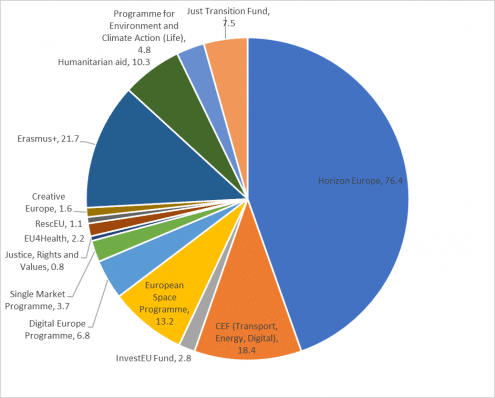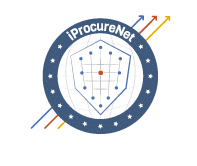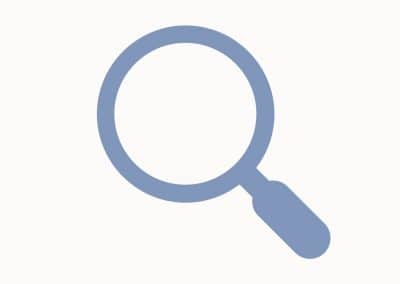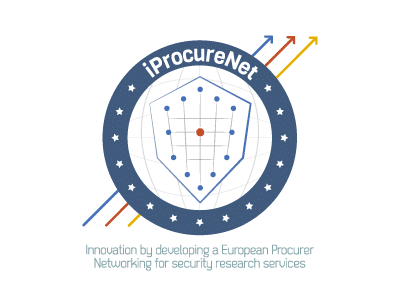Introduction
The following methodological explanation aims to support institutions on efficient implementation of financial instruments, providing information on the volume of and comparisons of different financing options for the new long-term EU budget period.
Overview
The following methodological explanation aims to support institutions on efficient implementation of financial instruments, providing information on the volume of and comparisons of different financing options for the new long-term EU budget period.
For any project, an organization needs to consider the available choices of funding, whether to carry out the project/procurement
- From the State (organization’s) budget,
- With funds from a Structural Fund financed by the EU and managed by the Member State, or
- Direct funding such as Horizon2020/Horizon Europe, or
- By combining different sources (such as ESIF).
Depending on the approach, self-financing issues should also be considered.
If the European Commission directly manages funding, it does so by awarding grants, launching tendering procedures.
The European Commission can contribute to the financing of projects and organizations contributing to the implementation of EU programs and policies. Funding is granted through calls for proposals and projects. To get project funding, organization need to identify the corresponding call/projects and carefully follow specific instructions on how to apply – each call is unique. To be eligible, as a rule, you need to look for a project partner in other countries and to compete for funding the proposed project.
In the field of security and defence, a new European Defence Fund will be set up to promote the competitiveness, efficiency and innovation capacity of the EU defence, technology and industrial base. Most sectoral EU funding programmes are expected to be adopted at the beginning of 2022 and will apply retrospectively from the beginning of 2021.
New and reinforced priorities, total €335 billion
/

Find below and extract for a list of funding programmes that directly or indirectly concerns enforcement agencies:
![]() https://www.consilium.europa.eu/en/infographics/mff2021-2027-ngeu-final/
https://www.consilium.europa.eu/en/infographics/mff2021-2027-ngeu-final/
In the area of internal security, the focus will, as a rule, be on AMIF, ISFP, ISFB and Horizon projects. From perspective of new period of Horizon Europe, calls for 2021-2022 are:
- Better protect the EU and its citizens against Crime and Terrorism
- Call – Fighting Crime and Terrorism 2021, 2022
- Effective management of EU external borders
- Call – Border Management 2021, 2022
- Protected Infrastructure
- Call – Protected Infrastructure 2021, 2022
- Increased Cybersecurity
- Call – Increased cybersecurity
- Disaster-Resilient Society for Europe
- Call – Disaster-Resilient Society 2021, 2022
- Strengthened Security Research and Innovation
- Call – Support to Security Research and Innovation 2021, 2022
- Other Study – Research on Infrastructure Protection and Resilience in Europe – lessons learned, trends and challenges (2021)
![]() https://ec.europa.eu/info/horizon-europe_en
https://ec.europa.eu/info/horizon-europe_en
Procurements in security sector are financed from a wide range of sources starting with the State budget to the EU funds and ending with the Seed Money Facility´s in regional level.
More than 76% of the EU grant budget is managed in partnership with national and regional authorities through a “shared management” system, largely through 5 big funds (the Structural & Investment Funds) that help to implement the Europe 2020 strategy:
- CF – Cohesion Fund, economic convergence by less-developed regions
- EAFRD – European Agricultural Fund for Rural Development
- EMFF – European Maritime and Fisheries Fund
- ERDF – regional and urban development
- ESF – European Social Fund, social inclusion and good governance
Other funds managed directly by the EU:
-
- Grants for specific projects in relation to EU policies – ‘call for proposals’
- Contracts issued by EU institutions to buy in services, goods or works they need for their operations
Internal Security Fund (ISF)
The ISF promotes the implementation of (i) the Internal Security Strategy, (ii) law enforcement cooperation and (iii) the management of the Union’s external borders.
The ISF is composed of 2 instruments:
-
- Borders and Visa (ISF Borders and Visa)
- Police cooperation, preventing and combatting crime, and crisis management (ISF Police).
Funding options for LEAs from ISF are:
- ISF Police (National Programme)
- ISF Borders (National Programme)
- ISF Police Direct payments (Community measures).
Asylum, Migration and Integration Fund (AMIF)
The general objective is to contribute to the effective management of migration flows and to the implementation, strengthening and further development of common asylum, subsidiary or temporary protection policies and common migration policies, while fully respecting the rights and principles enshrined in the Charter of Fundamental Rights of the European Union.
Structural Support (Structural Funds)
The structural funds comprises largely of 5 big funds:
- CF – Cohesion Fund, economic convergence by less-developed regions
- EAFRD – European Agricultural Fund for Rural Development
- EMFF – European Maritime and Fisheries Fund
- ERDF – Regional and Urban development
- ESF – European Social Fund, social inclusion and good governance
The ERDF focuses its investments on several key priority areas (‘thematic concentration’):
- Innovation and research;
- The digital agenda;
- Support for small and medium-sized enterprises (SMEs);
- The low-carbon economy.
Interreg V: European Territorial Cooperation: is one of the goals of cohesion policy and provides a framework for the implementation of joint actions and policy exchanges between national, regional and local actors from different Member States. It has three stands of cooperation:
- Cross-border
- Transnational
- Interregional
![]() European Structural and Investment Funds – Regional Policy – European Commission (europa.eu)
European Structural and Investment Funds – Regional Policy – European Commission (europa.eu)
HORIZON 2020 and HORIZON EUROPE: EU Framework Programme for Research and Innovation
Horizon 2020 is the world’s largest programme supporting R&D and international cooperation. Horizon 2020 brings resources together on three priorities of the Europe 2020 strategy and the Innovation Union flagship initiative.
There can be considered three large areas in Horizon 2020:
- excellent science
- industrial leadership, and
- social issues
OLAF Programmes
The Hercule programme protects the EU’s financial interests by supporting action to combat irregularities, fraud and corruption affecting the EU budget. It is administered by the European Anti-Fraud Office.
In the context of the new multiannual financial framework (2021-2027) the European Commission has adopted a proposal for a new EU Anti-Fraud Programme which is designed to support the efforts of the Commission and the EU Member States in:
- combating fraud and other illegal activities affecting the EU budget;
- mutual administrative assistance in the customs area;
- reporting of irregularities by EU Member States affecting EU funds
Connecting Europe Facility (CEF)
Connecting Europe Facility (CEF) Telecom programme is a key EU tool to facilitate crossborder cooperation between public administration, businesses and citizens by deploying digital service infrastructure (DSI) and broadband networks. Funded projects contribute to the EU Digital Single Market strategy.
It supports the development of high performing, sustainable and efficiently interconnected trans-European networks in the fields of transport, energy and digital services.
![]() European Climate, Infrastructure and Environment Executive Agency (europa.eu)
European Climate, Infrastructure and Environment Executive Agency (europa.eu)
Integrated Border Management Fund
The mission of BMVI is to ensure a strong and effective European integrated border management at the external borders of the Union, ensuring a high level of internal security of the Union, while protecting the free movement of persons within the Union.
Actions funded through BMV can include a wide range of initiatives, such as:
- financing of efficient services for visa applicants, while maintaining the security and integrity of visa procedures
- investing in common large-scale IT systems in border management and visa policy, including their interoperability
- investing in infrastructure and equipment, systems and services, training, exchange of experts, deployment of immigration liaison officers, innovative solutions and new technologies, research
- improving border controls, in line with the European Agenda on Migration and in line with the Charter of Fundamental Rights of the European Union, by enhancing cooperation at EU level to carry out border tasks
- providing operational support for the implementation of a single European border management and common visa policy
Digital Europe Program
The Digital Europe programme is aimed at accelerating Europe’s recovery and promoting digital transformation and financing projects in 5 key areas:
- Supercomputing
- Artificial intelligence
- Cybersecurity
- Advanced digital skills
- ensuring the wide use of digital technologies across the economy and society
Although drones, metal detectors and ballistic vests cannot be purchased by Digital Europe framework, there are references in past calls to the components of the operation of drones.
European Defence Fund
Is the Commission’s initiative to support collaborative defence research and development, and to promote an innovative and competitive defence industry base
Is not aimed directly for financing internal security domain, but internal security projects or agencies might be able to benefit from such financing options, depending on the circumstances.
The Fund should promote better exploitation of the industrial potential of innovation, research and technological development at every stage of the industrial life cycle, thus contributing to the strategic autonomy of the Union.
Union Civil Protection Mechanism
It will support the efforts of Member States and additional participating countries to protect people, as well as the environment and property, including cultural heritage, against any natural or man-made threats, including consequences of terrorist offences, technological, radiological or environmental disasters, marine pollution and health emergencies occurring within and outside the Union.
The analysis of financial tools and programmes indicated that COTS products are suitable for JCBPP.
Procurement of innovative solutions or their prototypes can also be procured under JCBPP mechanisms and, depending on the specific focus and purpose of the segment, ISFB, ISFP and Horizon Europe are suitable for the procurement.
JCBPP and IP in the Security Sector
JCBPP and IP in the Security Sector
Joint Cross-Border Public Procurement (JCBPP)
Innovation Procurement (IP)
How to: Guide for JCBPP & IP
Ethics in procurement























